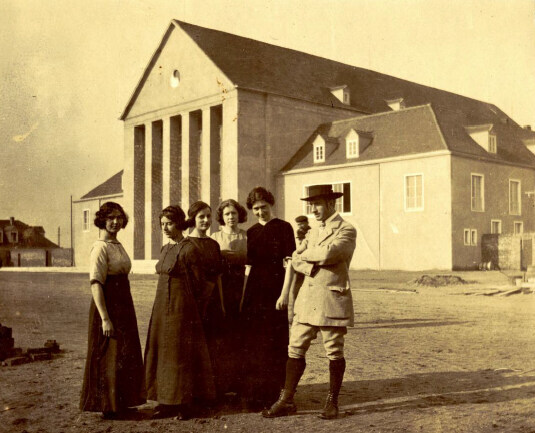Nijinsky – Life and work
On 24th of January, 2025, John Neumeier‘s masterpiece Nijinsky will celebrate its premiere at the Semperoper Ballett. To mark the 200th anniversary of the company, this legendary dance figure returns to Dresden, where Vaslav Nijinsky (1889-1950) went on tour with the Ballets Russes in 1912/13.
As a tribute to the dance icon, we are presenting milestones of Nijinsky‘s life and work – a complex artist who continues to influence and inspire dancers worldwide until today.

Nijinsky in Danse siamoise from the Orientales © John Neumeier Stiftung
„Nijinsky’s life can be simply summarized: ten years of growing, ten years of learning, ten years of dancing, thirty years in eclipse.”
Richard Buckle

Playbill from the first guest performance of the Ballets Russes on 13 February 1912 in Dresden © Historisches Archiv der Sächsischen Staatstheater Dresden
In 1909, the Ballets Russes, founded by impresario Serge Diaghilev and the two costume- and stage designers Alexandre Benois and Léon Bakst, performed in Paris for the very first time and from there conquered the western world.
On 13th February in 1912, the ballet ensemble led by star dancer Vaslav Nijinsky made its first guest appearance in Dresden – further performances at the Semperoper were to follow – they presented such successful works as Le Pavillon d'Armide, Carnaval and Scheherazade, choreographed by Michel Fokine. John Neumeier will bring reminiscences of these works to the stage of the Semperoper in his masterwork Nijinsky.
Wherever they performed, the Ballets Russes caused a sensation with their sensually expressive dance creations – the world had never seen anything like this!
As children of professional dancers, Vaslav Nijinsky and his siblings were born with a talent for dance: Vaslav and his elder brother Stanislav (1886-1917) performed in an opera production in Odessa as children, Bronislava Nijinska (1891-1972) later became a member of the Mariinsky Ballet in St. Petersburg as well as a dancer and choreographer for the Ballets Russes.
Both his mother Eleonora and brother Stanislav as well as Vaslav himself suffered from severe depression and mental disorders, Stanislav was even committed to a psychiatric clinic from 1902. Vaslav Nijinsky, who had performed in public for the last time in a hotel in St. Moritz in 1919, died in 1950 after 30 years of illness.
John Neumeier‘s ballet Nijinsky begins with this last legendary performance in Switzerland and takes the audience on a touching and disturbing journey through the life of the dancer of the century.
Vaslav Nijinsky not only danced with the two star ballerinas Tamara Karsavina and Anna Pavlova with the Ballets Russes and the Mariinsky Ballet, but also trained with them at the St. Petersburg Imperial Ballet School.
In 1907, Nijinsky completed his training with the role of the Slave in Michel Fokine‘s ‘Pavillon d'Armide’, in which he danced alongside Anna Pavlova. Vaslav made his first guest appearance at the Dresden Semperoper with the same ballet on 13 January 1912 – here partnering Tamara Karsavina.

© Semperoper Dresden | Serghei Gherciu; Pawlowa & Nijinsky in Der Pavillion der Armida (1907), Privatsammlung.

Vaslav Nijinsky in Petrushka, Elliott & Fry, London 1911 © John Neumeier Stiftung
Nijinsky as Harlequin in ‘Carnaval’, the Spirit of the Rose in Le Spectre de la rose, the Golden Slave in Scheherazade or as the Faun in L‘après midi d'un faune – the legendary star dancer caused storms of enthusiasm in all his artistic facets.
But no other role seems so closely linked to Vaslav Nijinsky‘s personal life and so deeply inscribed in his soul as the title character in Petrushka.
John Neumeier has created a monument to all these legendary stage roles in Nijinsky and proves once again why Nijinsky is regarded as a key figure of the century and a unique phenomenon in dance history.
In John Neumeier's two-part ballet Nijinsky, in which the entire ensemble of the Semperoper Ballett is involved, the costume and set designs play a decisive role, as it was typical in the history of the Ballets Russes.
In addition to the choreography, Neumeier is also responsible for the set and costumes of the production, using some of the original designs by Léon Bakst and Alexandre Benois.
Like the choreographic rehearsals with the dancers, the costumes and the stage design are increasingly taking on their final form from day to day in the workshops of the Semperoper.

Vaslav Nijinsky als Faun, Zeichnung von Léon Bakst | John Neumeier Stiftung

Hellerau © Collections of the Bibliothèque de Genève
In 1913, it became one of the biggest theatre scandals in the history of dance, today it is considered a key work of modernism: Vaslav Nijinsky‘s choreography Le Sacre du Printemps to Igor Stravinsky's groundbreaking composition.
Dresden-Hellerau became a decisive place of artistic inspiration for Nijinsky. In the year of the premiere, Vaslav Nijinsky and his patron Serge Diaghilev visited Marie Rambert, who was teaching at the renowned Institute for Music and Rhythm as assistant to Émile Jaques-Dalcroze – the so called founder of rhythmic gymnastics.
Rambert unquestionably had a choreographic influence on the creation of this masterpiece and was present at all 120 of Nijinsky's Sacre rehearsals as well as the scandalous premiere in Paris.